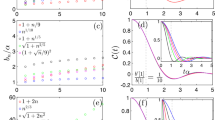Summary
We present in a rather pedagogical way a new formulation of quantum mechanics. Our starting point is the path integral representation of the quantum-mechanical propagator analytically continued to imaginary timeW(X″, s″|X′, s′). We view the set of random paths contributing toW(X″, s″|X′, s′) as the manifold of solutions of a Langevin equation with a Gaussian white noise. We thus obtainW(X″, s″|X′, s′) as the noise-average of a suitable functional of the solution of the Langevin equation. The standard quantum-mechanical propagator is finally recovered by analytically continuingW(X″, s″|X′, s′) back to real time. The present approach allows for a straightforward application of standard methods of classical stochastic processes to quantum-mechanical problems and offers a new promising way to perform computer simulations of quantum-dynamical systems.
Riassunto
Si presenta in un modo piuttosto pedagogico una nuova formulazione della meccanica quantistica. Il punto di partenza è costituito dalla rappresentazione, in termini di integrale di cammino, del propagatore quanto-meccanicoW(X″, s″|X′, s′) prolungato analiticamente nel tempo immaginario. Si considera l'insieme dei cammini casuali che contribuiscono aW(X″, s″|X′, s′) come l'insieme delle soluzioni dell'equazione di Langevin in presenza di un rumore bianco gaussiano. Si ottiene alloraW(X″, s″|X′, s′) come media su rumore di un opportuno funzionale della soluzione dell'equazione di Langevin. L'usuale propagatore quantistico è poi riottenuto con un ulteriore prolungamento analitico al tempo reale. Questa formulazione consente una diretta applicazione dei metodi dei processi stocastici classici a problemi quantistici e rappresenta un nuovo promettente modo di effettuare simulazioni numeriche di sistemi quanto-meccanici.
Резюме
С педагогической целью мы предлагаем новую формулировку квантовой механики. Мы исходим из представления, использующего интегрирование по траекториям, кватовомеханического пропагатора, аналитически продолженного в область мнимого времениW(X″, s″|X′, s′). Мы рассиатриваем систему случайных траекторий, вносящих вклад вW(X″, s″|X′, s′), как множество решений уравнения Ланжевена в случае гауссова белого шума. Мы получаемW(X″, s″|X′, s′), как среднее по шуму для соответствующего функционала решения уравнения Ланжевена. Стандартный квантовомеханический пропагатор восстанавливается с помошью аналитического продоженияW(X″, s″|X′, s′) обратно в область вещественного времени. Предложенный подход позволяет непосредственно применять стандартные методы классических стохастических процессов к квантовомеханическим проблемам и представляет новый метод для проведения компьютерного моделирования квантоводинамических систем.
Similar content being viewed by others
References
G. Parisi andWu Yongshi:Sci. Sin.,24, 483 (1983). For a review, seeP. H. Damgaard andH. Huffel:Phys. Rep. 152, 227 (1987).
Seee.g. G. Parisi:Les Houches Session XLIII (1984), edited byK. Osterwalder andR. Stora (North-Holland, Amsterdam, 1986).
E. Schrödinger:Berl. Sizber., 144 (1931);E. Schrödinger:Ann. Inst. Henry Poincaré,2, 269 (1932).
R. Fürth:Z. Phys.,81, 143 (1933).
For an incomplete list of references seee.g. ref..
M. Jammer:The Philosophy of Quantum Mechanics (J. Wiley, N.Y., New York 1976). See also ref.
G. C. Ghirardi, C. Omero, A. Rimini andT. Weber:Riv. Nuovo Cimento,1, 1 (1978).
E. Nelson:Phys. Rev.,150, 1079 (1966);E. Nelson:Dynamical Theories of Brownian Motion (Princeton University Press, Princeton, N.J., 1967);E. Nelson:Quantum Fluctuations (Princeton University Press, Princeton, N.J., 1984). For a particular clear presentation of stochastic mechanics and its connection with quantum field theory, see:F. Guerra:Phys. Rep.,77, 263 (1981).
F. Guerra:On the Connection between Euclidean-Markov Field Theory and Stochastic Quantization, inProc. S.I.F., Course LX (North-Holland, Amsterdam, 1976);F. Guerra:Phys. Rep.,77, 263 (1981).
R. P. Feynman:Rev. Mod. Phys.,20, 367 (1948);R. P. Feynman andA. R. Hibbs:Quantum Mechanics and Path-Integrals (McGraw-Hill, New York, N.Y., 1965).
G. Parisi:Nucl. Phys. B,180, 379 (1981);205, 337 (1982).
More precisely Lagrangian (2.1) describes gravitational interactions in the approximation where the space-space part of the four-dimensional metric tensor can be considered constant.
H. Weyl:The Theory of Groups and Quantum Mechanics (Dover, New York, N.Y., 1950). See also,e.g.,T. D. Lee:Particle Physics and Introduction to Field Theory (Harwood Academic Publishers, New York, N.Y., 1981).
Obviously, whenever we talk aboutprobability for a continuous variable we always meanProbability density!
We are implicitly assuming that the Hamiltonian has a well-defined ground state.
Feynman's original assumption was made for theLagrangian path integral, but, in general, the correct procedure is to start from theHamiltonian path integral.
See,e.g.,S. Pokorski:Gauge Field Theories (Cambridge University Press, Cambridge, 1987).
This point is explained,e.g. inL. S. Schulman:Thechniques and Applications of Path Integration (J. Wiley, New York, N.Y., 1981).
See,e.g.,H. P. McKean:Stochastic Integrals (Academic Press, New York, N.Y., 1969).
F. A. Berezin:Theor. Math. Phys.,6, 194 (1971).
M. M. Mizrahi:J. Math. Phys. (N.Y.),16, 2201 (1975). See alsoT. D. Lee:Particle Physics and Introduction to Field Theory (Harwood Academic Publishers, New York, N.Y., 1981).
The analytic continuation of eitherA i(X, t) or ϕ(X, t) is a standard practice in gauge theories see,e.g.,K. Huang:Quarks, Leptons, and Gauge Fields (World Scientific Publishing Co., Singapore, 1982).
See,e.g.,R. Graham:Z. Phys. B,26, 281 (1977).
See,e.g.,I. M. Gel'fand andA. M. Yaglom:J. Math. Phys. (N.Y.),1, 48 (1960) and ref. (23).R. Graham;Z. Phys. B,26, 281 (1977).
The mathematical origin of eq. (2.30) is the same as that of eq. (2.16).
A. Einstein:Investigations on the Theory of the Brownian Movement (Methuen and Company, London, 1926);M. Von Smoluchowski:Abhandlungen über die Brownsche Bewegung und Verwandte Erscheinungen (Akademische Verlagsgesellschaft, Leipzig, 1923). See also,e.g.,H. Risken:The Fokker-Planck Equation (Springer, New York, N.Y., 1984).
This equation is often called Smoluchowski equation.
See ref. We point out that the difference between eq. (3.5) and the result ofF. W. Wiegele:Physica,37, 105 (1967) arises from a different discretization prescription.
P. Langevin:C. R. Acad. Sci.,146, 530 (1908). See also,e.g.,H. Risken:The Fokker-Planck Equation (Springer, New York, N.Y., 1984).
See,e.g.,E. Gozzi:Phys. Rev. D,28, 1922 (1983).
E. Witten:Nucl. Phys. B,186, 253 (1981).
G. Parisi andN. Surlas:Nucl. Phys. B,206, 321 (1982);S. Cecotti andL. Girardello:Ann. Phys. (N.Y.),145, 81 (1983);M. V. Felgel'man andA. M. Tsvelik:Sov. Phys. JETP,56, 823 (1982).
E. Gozzi:Phys. Lett. B,129, 432 (1983).
F. Guerra:Phys. Rep.,77, 263 (1981).
Author information
Authors and Affiliations
Additional information
To speed up publication, the author has agreed not to receive proofs which have been supervised by the Scientific Committee.
Rights and permissions
About this article
Cite this article
Roncadelli, M. Langevin formulation of quantum mechanics. Il Nuovo Cimento D 11, 73–99 (1989). https://doi.org/10.1007/BF02450234
Received:
Issue Date:
DOI: https://doi.org/10.1007/BF02450234




